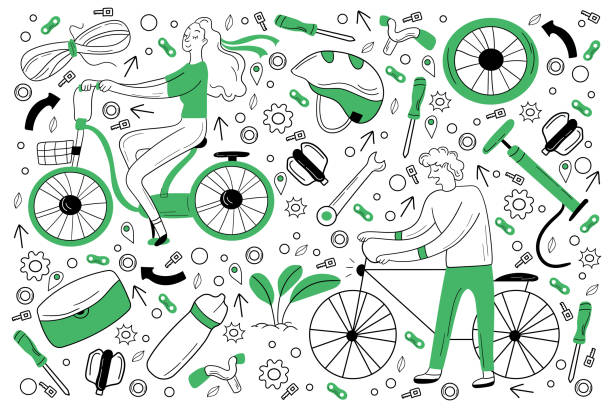Hey fellow riders! At Beavers Sports Shop, we are experienced mountain biker who’s spent countless hours on the trails, and now we’re here to share our knowledge on keeping your mountain bike in peak condition. Maintaining your bike is crucial for both safety and performance, and it’s something every rider should be comfortable with. Whether you’re a weekend warrior or an everyday trailblazer, this comprehensive guide will walk you through everything you need to know about mountain bike maintenance. Let’s dive in and ensure your bike is always ready for the next adventure!
Introduction to Bike Maintenance
Mountain biking is an adrenaline-packed sport, but it can be hard on your equipment. Regular maintenance is essential to keep your bike performing at its best and to prevent costly repairs down the road. Proper bike maintenance not only ensures a smoother ride but also extends the life of your mountain bike. Whether you’re new to mountain biking or a seasoned pro, understanding how to care for your bike is key to enjoying the sport safely and effectively.
In this guide, we’ll cover the basics of routine maintenance, delve into specific areas like tire care, brake adjustments, and drivetrain cleaning, and finish with a look at suspension maintenance and the essential tools you’ll need. By following these tips, you’ll keep your mountain bike in top shape, ready to tackle any trail. Let’s get started!
Routine Maintenance Checklist
Routine maintenance is the foundation of keeping your mountain bike in excellent condition. By performing regular checks and basic upkeep, you can avoid more significant issues and ensure your bike is always ready to ride. Here’s a comprehensive checklist to guide your routine maintenance:
- Cleaning Your Bike: After every ride, especially in muddy or wet conditions, give your bike a thorough cleaning. Use a gentle bike-specific cleaner and a soft brush to remove dirt and grime from the frame, wheels, and components. Avoid using high-pressure water, as it can force water into sensitive areas like bearings.
- Lubricating the Chain: The chain is the heart of your bike’s drivetrain, and keeping it well-lubricated is crucial. After cleaning, apply a bike-specific chain lubricant. Be sure to wipe off any excess to avoid attracting dirt. Regular lubrication prevents rust and ensures smooth shifting.
- Checking Tire Pressure: Proper tire pressure is vital for optimal performance and safety. Use a reliable tire gauge to check the pressure before each ride. Tire pressure can vary depending on the terrain, so adjust accordingly—higher pressure for hard-packed trails, and lower pressure for more grip on loose or rocky terrain.
- Inspecting Brakes: Before every ride, check that your brakes are functioning correctly. Squeeze the brake levers and ensure they engage smoothly. Look for any signs of wear on the brake pads and replace them if they’re worn down. Brake maintenance is crucial for safety, so don’t skip this step.
- Tightening Bolts: Over time, vibrations from riding can cause bolts to loosen. Periodically check and tighten all bolts on your bike, especially those on the handlebars, stem, and suspension. Use a torque wrench to ensure bolts are tightened to the manufacturer’s specifications to avoid over-tightening.
- Inspecting the Drivetrain: Regularly inspect the drivetrain components—chain, cassette, and chainrings—for signs of wear. A worn drivetrain can lead to poor shifting and reduced performance. If you notice any significant wear, it’s time to replace the affected parts.
- Checking Suspension: Your bike’s suspension is critical for handling rough terrain. Periodically check the suspension settings and ensure there are no leaks or unusual noises. Suspension maintenance is more advanced, so consider consulting your bike’s manual or a professional if needed.
Tire Care and Replacement
Your tires are your connection to the trail, so keeping them in good shape is essential for a safe and enjoyable ride. Here’s how to care for your tires and know when it’s time for a replacement:
- Inspecting Tire Tread: Regularly check your tire tread for signs of wear. The tread provides traction, and as it wears down, you’ll lose grip on the trail. If the tread is significantly worn, especially in the center, it’s time to replace the tire.
- Checking for Damage: Examine your tires for cuts, punctures, or any other damage. Sidewall cuts can lead to blowouts, while punctures can cause slow leaks. If you find any significant damage, it’s best to replace the tire to avoid issues on the trail.
- Replacing Tires: When replacing tires, consider the type of riding you do. Cross-country riders may prefer lightweight, fast-rolling tires, while downhill riders need more robust, grippy tires. Make sure to choose a tire that suits your riding style and the terrain you typically ride on.
- Tubeless Setup: If you’re running a tubeless setup, check the sealant levels regularly and top up as needed. Tubeless tires offer better puncture resistance and can be run at lower pressures for improved traction, making them a popular choice among mountain bikers.
- Maintaining Proper Pressure: As mentioned earlier, maintaining the correct tire pressure is crucial. Too low, and you risk pinch flats and poor handling; too high, and you lose traction and comfort. Refer to your tire’s sidewall for the recommended pressure range and adjust based on your weight and riding conditions.
Brake Maintenance and Adjustments
Brakes are one of the most critical components of your mountain bike, and keeping them in top condition is essential for your safety. Here’s how to maintain and adjust your brakes:
- Inspecting Brake Pads: Over time, brake pads wear down and lose effectiveness. Check the thickness of your brake pads regularly, and replace them if they’re worn down to the manufacturer’s minimum recommended thickness. Worn pads can damage your rotors and reduce stopping power.
- Adjusting Brake Calipers: If your brakes are rubbing or not engaging properly, you may need to adjust the brake calipers. Loosen the caliper bolts, squeeze the brake lever, and re-tighten the bolts while holding the lever. This helps center the caliper over the rotor for optimal performance.
- Bleeding Hydraulic Brakes: If you have hydraulic brakes, they may need to be bled periodically to remove air bubbles and ensure consistent braking performance. Bleeding brakes can be a bit tricky, so consult your bike’s manual or take it to a professional if you’re not comfortable doing it yourself.
- Checking Brake Rotors: Inspect your brake rotors for warping or damage. If you notice any irregularities, such as a wobbly rotor or uneven wear, it might be time to replace it. Also, clean the rotors regularly with isopropyl alcohol to remove any dirt or oil that could reduce braking efficiency.
- Cable Maintenance (for Mechanical Brakes): If you’re running mechanical disc brakes, check the brake cables for fraying or corrosion. Lubricate the cables to keep them moving smoothly, and replace them if they show any signs of wear. Properly tensioned cables ensure responsive braking.
Drivetrain Cleaning and Lubrication
Your bike’s drivetrain is a complex system that requires regular care to keep your bike shifting smoothly and efficiently. Here’s how to maintain it:
- Cleaning the Drivetrain: Start by cleaning the chain, cassette, and chainrings. Use a degreaser to break down grime and dirt, then scrub the components with a brush. Rinse everything thoroughly and allow it to dry before applying lubricant.
- Lubricating the Chain: Apply a bike-specific chain lubricant to each link of the chain, then wipe off any excess. Too much lubricant can attract dirt, so less is more. Lubricating the chain reduces friction, prolongs the life of the drivetrain, and ensures smooth shifting.
- Inspecting for Wear: Regularly inspect your drivetrain components for wear. Look for stretched chains, worn teeth on the cassette and chainrings, and any signs of rust. A worn drivetrain can lead to poor shifting and increased wear on other components, so replace parts as needed.
- Adjusting Derailleurs: If your bike isn’t shifting smoothly, you may need to adjust the derailleurs. Check the alignment of the derailleur hanger, and make sure the limit screws are set correctly. Fine-tuning the cable tension can also improve shifting performance. If you’re unsure how to do this, consider watching tutorial videos or consulting your bike’s manual.
- Replacing Worn Components: Over time, chains, cassettes, and chainrings wear out and need to be replaced. Replacing a worn chain before it damages the cassette and chainrings can save you money in the long run. Use a chain wear indicator tool to check for chain stretch and replace it when necessary.
Tools and Resources for Bike Maintenance
Having the right tools makes bike maintenance much easier and more effective. Here’s a list of essential tools and resources to keep your mountain bike in top shape:
- Basic Tools: Invest in a good set of Allen wrenches, a torque wrench, tire levers, and a multi-tool. These will cover most of your basic maintenance needs.
- Chain Tool: A chain tool is essential for removing and replacing chains, especially if you’re replacing a worn chain or making emergency repairs on the trail.
- Bike Stand: A bike stand makes maintenance much easier by holding your bike securely at a convenient height. It’s a worthwhile investment for anyone serious about maintaining their bike.
- Torque Wrench: Use a torque wrench to ensure that bolts are tightened to the manufacturer’s specifications, preventing over-tightening and damage.
- Online Resources and Tutorials: The internet is a treasure trove of bike maintenance tutorials and guides. Websites, forums, and YouTube channels dedicated to mountain biking can provide step-by-step instructions for almost any maintenance task. Some recommended resources include Park Tool’s website/YouTube Channel and PinkBike’s Forums .
Maintaining your mountain bike doesn’t have to be a daunting task. With the right knowledge, tools, and routine, you can keep your bike in excellent condition, ensuring it’s always ready for your next ride. Regular maintenance not only extends the life of your bike but also enhances your riding experience by keeping everything running smoothly.
So, get out there and start wrenching! Whether you’re cleaning your chain, adjusting your brakes, or fine-tuning your suspension, each task brings you one step closer to mastering your bike and the trails. Happy riding!
Visit our repair shop site here for more details on how we can help assist you in maintaining your bike!





